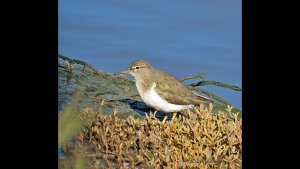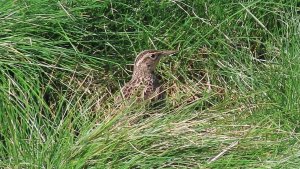-
Welcome to BirdForum, the internet's largest birding community with thousands of members from all over the world. The forums are dedicated to wild birds, birding, binoculars and equipment and all that goes with it.
Please register for an account to take part in the discussions in the forum, post your pictures in the gallery and more.
california
-

A Pretty Phoebe (2)
Say’s Phoebe — This is the second of a pair of posts. I made many shutter clicks and chose this one for the clear image of its back. Feathers like a soft, warm cloak. NX Studio was used to crop, adjust levels, and sharpen the image.- Jamulbob
- Media item
- california jamul san diego sayornis saya say’s phoebe
- Comments: 2
- Category: North America
-
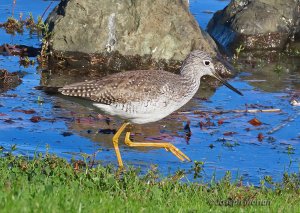
Greater Yellowlegs
The smudgy, relatively unstreaked breast and gray mantle indicate nonbreeding (Definitive Basic) plumage. However, we can see a few new black streaks showing up on the flanks and neck indicating the beginning of a change to breeding (alternate) plumage. This species prefers inhospitable...- jmorlan
- Media item
- california greater yellowlegs tringa melanoleuca usa
- Comments: 3
- Category: North America
-
J
North America, California, San Diego, semi-arid, Kingbird
This is North America, California, San Diego, semi-arid. I’m uncertain about naming of this bird. Perhaps a juvenile Cassin’s Kingbird. Its flycatching, perching, and habitat are consistent. However, the very light coloring of the breast and back, and the rust-colored belly are a bit confusing...- Jamulbob
- Thread
- california kingbird north america san diego semi-arid
- Replies: 4
- Forum: Bird Identification Q&A
-
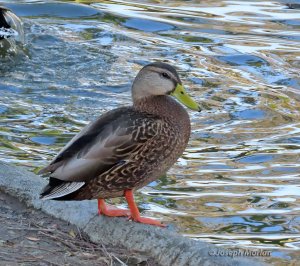
Mallard x Mexican Duck (Anas platyrhynchos x diazi)
This odd duck caused some confusion at first, but the dust seems to have settled and the consensus is that this is a hybrid between Mallard and Mexican Duck. Mexican Duck has a rather tortured taxonomic history, formerly being classified as a separate species but then lumped with Mallard...- jmorlan
- Media item
- anas diazi anas platyrhynchos california hybrid mallard mexican duck usa
- Comments: 2
- Category: North America
-
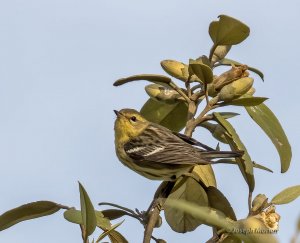
Blackburnian Warbler
This species is a very rare migrant in California mostly in the Fall with only occasional winter records. They normally winter in the mountains of northern South America. This immature female was discovered in this small hilltop park on 9 January. Note the gray rather than black eyeline combined...- jmorlan
- Media item
- blackburnian warbler california setophaga fusca usa
- Comments: 2
- Category: North America
-
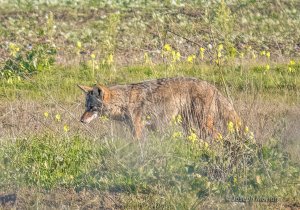
Coyote (Canis latrans)
On the prowl, this is the race "C. l. ochropus," sometimes called the "California Valley Coyote." It is a more golden or ocher color, slightly darker and less gray than other races. It also averages slightly smaller. They remind me of African Jackals and are sometimes called the American...- jmorlan
- Media item
- california canis latrans coyote usa
- Comments: 1
- Category: Wild Mammals
-
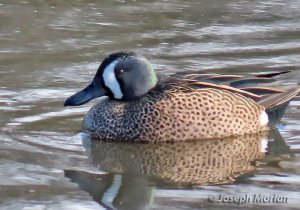
Blue-winged Teal
This is a male. Scarce but possibly increasing in the Far West, Phelps Slough is one of the more reliable places to see Blue-winged Teal in San Mateo County. Formerly included in the genus "Anas" but moved to "Spatula" to preserve monophyly of "Anas."- jmorlan
- Media item
- blue-winged teal california spatula discors usa
- Comments: 3
- Category: North America
-
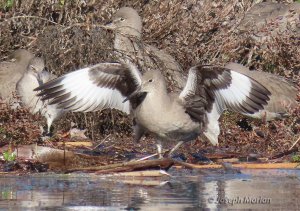
Willet
This common shorebird looks uniformly drab gray in non-breeding plumage until it spreads its wings offering a very different appearance. The Willet is a strictly North American breeding bird with two populations. This is the larger "Western Willet" (T. s. inornata) which breeds inland in the...- jmorlan
- Media item
- california tringa semipalmata usa willet
- Comments: 2
- Category: North America
-
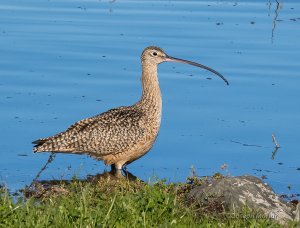
Long-billed Curlew
This is the largest North American shorebird. It is largely a grassland species breeding in the western plains and wintering primarily in Mexico. However it is not uncommon in the valleys and coasts of California in migration and in the winter. These birds are highly skilled at manipulating...- jmorlan
- Media item
- california long-billed curlew numenius americanus usa
- Comments: 4
- Category: North America
-
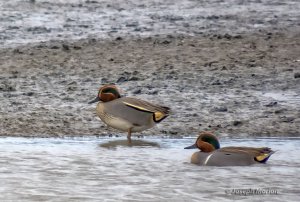
Eurasian and American Green-winged Teal
The bird on the left is the Eurasian form (rare here) while the bird on the right is the American version. These are adult males. The females are almost indistinguishable. Many authorities regard these as two different species because of strong genetic divergence, but the AOS and eBird still...- jmorlan
- Media item
- anas crecca california common teal green-winged teal usa
- Comments: 4
- Category: North America
-
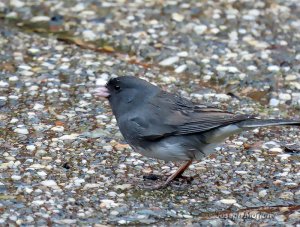
Dark-eyed Junco
Formerly split under the name "Slate-colored Junco" this nominate race is an uncommon migrant and winter visitor to California. This one has been visiting our backyard off-and-on for the last week. It differs from the expected "Oregon Junco" group in lacking a defined dark hood and in lacking...- jmorlan
- Media item
- california dark-eyed junco junco hyemalis slate-colored usa
- Comments: 2
- Category: North America
-

Ridgway's Rail
These secretive endangered rails come out of the salt marshes when the tide is high. They are the largest subspecies "R. o. obsoletus" which are confined to salt marshes around San Francisco Bay. Formerly abundant, this species declined precipitously because of over-hunting and habitat loss...- jmorlan
- Media item
- california rallus obsoletus ridgway's rail usa
- Comments: 4
- Category: North America
-
Spotted Sandpiper
In winter plumage these birds lack spots. The function of their characteristic "teetering" behavior in which their whole rear-end bobs up and down is one of the unsolved mysteries of Ornithology. It appears to have evolved independently in several unrelated birds such as waterthrushes. Teetering...- jmorlan
- Media item
- actitis macularius california spotted sandpiper usa video
- Comments: 2
- Category: North America
-

Marbled Godwit
Marbled Godwits are common migrants and winter visitors to our shores from breeding grounds in the interior of Canada and the northern prairies of the US. They look very similar year round, but the lack of dark bars on the underparts of this individual indicate it is in winter plumage. There are...- jmorlan
- Media item
- california limosa fedoa marbled godwit usa
- Comments: 2
- Category: North America
-

Short-billed Dowitcher
In winter plumage the two dowitcher species (Long-billed and Short-billed) are very difficult to distinguish. We identified these dowitchers by call and heard only Short-billed. Short-billed is more locally distributed than Long-billed in winter, being confined to large bays with extensive...- jmorlan
- Media item
- california flight limnodromus griseus short-billed dowitcher usa
- Comments: 3
- Category: North America
-

Prairie Warbler
This is a very rare winter visitor to California from the Eastern United States. Most records are from along the immediate coast and mostly in the Fall with only a handful of Spring records. Accidental in Winter, this is one of two currently wintering in Northern California, the other being at...- jmorlan
- Media item
- california prairie warbler setophaga discolor usa
- Comments: 2
- Category: North America
-

Mockingbird on its lookout perch
Northern Mockingbird — I often see one or more mockingbirds in this scraggly topped sumac bush. An ideal place to watch over its territory. NX Studio was used to crop, adjust levels, and sharpen the image.- Jamulbob
- Media item
- california jamul mimus polyglottos northern mockingbird san diego
- Comments: 2
- Category: North America
-
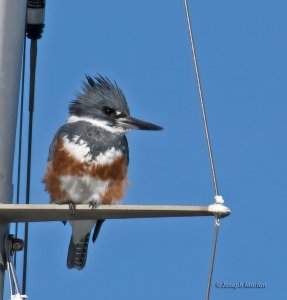
Belted Kingfisher
This is the only species of kingfisher found over most of the continental US. This female was perched on the spire of a small yacht overlooking the harbor. Males lack the chestnut band across the breast. Although birds on the West coast average slightly larger, there is apparently too much...- jmorlan
- Media item
- belted kingfisher california megaceryle alcyon usa
- Comments: 6
- Category: North America
-
Black-necked Stilt
Closely related to Avocets, I was struck how this individual used its bill to sweep through the mud using precisely the same feeding strategy as the American Avocet.- jmorlan
- Media item
- black-necked stilt california himantopus mexicanus usa video
- Comments: 2
- Category: North America
-

Redhead
Locally uncommon, this nondescript female was associating with a flock of Mallards begging for hand-outs. This individual was first reported here 14 November but possibly the same bird seen in 2018-2019 returning after going missing for a year . It frequently gets confused with female...- jmorlan
- Media item
- aythya americana california redhead usa
- Comments: 1
- Category: North America
-

Blue-winged Teal
Usually concealed by scapulars except in flight, the powder blue coverts which give this species its name are partly visible here. This species replaces the Cinnamon Teal throughout much of eastern and northern North America, especially in the Prairie Pothole region. However, here in the far...- jmorlan
- Media item
- blue-winged teal california spatula discors usa
- Comments: 1
- Category: North America
-
Western Meadowlark
Same bird as previous still image.- jmorlan
- Media item
- california sturnella neglecta usa video western meadowlark
- Comments: 1
- Category: North America
-
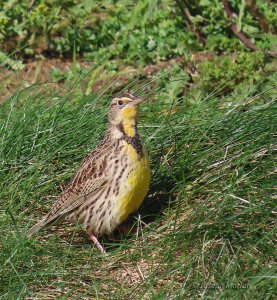
Western Meadowlark
Although resident in much of Western North America, this species moves locally from breeding in green grassy hill country to wintering in small flocks in lowland pastures and weedy fields. They are usually rather shy, seldom allowing close approach. In fresh plumage the black breast marking may...- jmorlan
- Media item
- california sturnella neglecta usa western meadowlark
- Comments: 1
- Category: North America
-

Mulch Maids (Leratiomyces percevalii)
Upon leaving the "duck pond" we noticed these showy mushrooms growing in woodchips landscaped around the pond. They turned out to be Mulch Maids (Leratiomyces percevalii), a mushroom that commonly grows in woodchip mulch after a rain. Apparently the caps start out convex yellow but turn concave...- jmorlan
- Media item
- california leratiomyces percevalii mulch maids usa
- Comments: 1
- Category: Wild Flowers, Trees, Shrubs, Fungi
-

MacGillivray's Warbler
Notorious skulkers, this is a singing male. Although increasing, they are still an uncommon breeder in the San Francisco Bay Area lowlands. They generally breed at higher elevations in the mountains where they prefer dense stands of Manzanita. Formerly placed in the genus "Oporornis" but now in...- jmorlan
- Media item
- california geothlypis tolmiei macgillivray's warbler usa
- Comments: 1
- Category: North America




